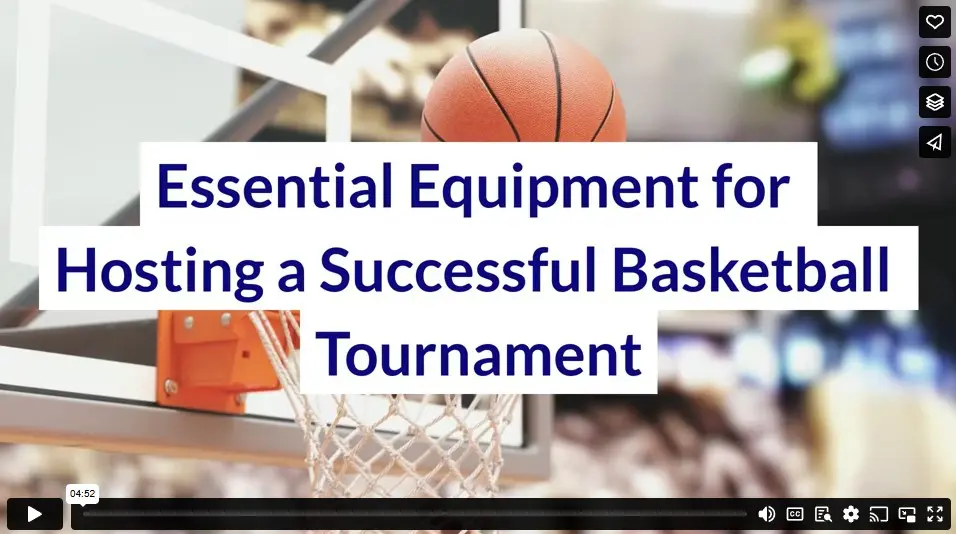Even though basketball season is officially October through April, it has become a year-round sport. For many high school and club teams, playing in basketball tournaments outside of the regular season is common. These tournaments offer athletes the opportunity to hone their skills, learn to work together as a team, and get experience playing teams they may not otherwise have the opportunity to play.
The logistics involved in organizing and making a tournament a success include, choosing a venue, negotiating rental agreements, recruiting teams to join, marketing, and registration. It all takes a lot of time and planning.
Before you get bogged down in the nitty gritty, there are essential details that seem obvious but cause trouble when overlooked. Having the right equipment to run the tournament is imperative. Without the basics, a tournament cannot go on. This article will look at the most basic equipment needed to run a basketball tournament.
Quality Flooring
Basketball is a high-intensity sport. The action on the court happens quickly, with lots of stops and starts. It is also a high-contact sport, as players bump into each other, slap the ball away, and jump over each other. One of the first things to consider is the state of the basketball court.
The court must be level for the protection of the players. It must be free from cracks or bumps that may catch a foot and cause a fall. Twisted ankles are a common injury, but they should not happen due to an unsafe floor.
It is also important to check the court’s traction. “traction” refers to the grip between the basketball shoes and the court. Too much traction can cause a shoe to stick hard, resulting in a sprained ankle or a twisted knee. Too little traction means the floor is slippery, causing all kinds of chaos in such a fast-paced game.
Sturdy Basketball Hoops
A basketball hoop may seem too obvious, but two hoops must be present for a proper basketball tournament. For players ages twelve and up, the basketball system should be set at the regulation height of 10-feet, though organizers may modify the height for players of different ages and abilities.
The hoops must have a backboard and a net. They should also be sturdy: safely mounted or weighed down when using portable basketball goals so as not to tip and injure players. The backboards should be made of a high-quality material to prevent breaking. Heavy-duty basketball hoops will protect tournament participants from being injured by any kind of basketball hoop malfunction.
Dedicated Table Space
There must be space for organizers and referees to track the game. This space is usually a table set at midcourt, dividing the opposing team benches. The table should be long enough to seat three people: the person managing the clock and keeping score, the person tracking game statistics, and possibly a referee. It should also be big enough to hold the score box and the possession arrows. This table also needs pens, scorecards, and a basket or filing system to help with organization.
Scoreboards and Clocks
There are a few options for tracking the score of a basketball game. Depending on your venue and budget, you may have electronic scoreboards that quickly change with a button or flip chart. No matter how you track the score, the coaches, players, and spectators need to see the scoreboard and know how many points their team has.
Many electronic scoreboards also house the clock system, but the clock may also be on the table managing the game for smaller venues. Clocks can also be big or small but must also be visible to the coaches and players. Clock management is vital to the game.
Places to Sit
Each team needs a bench or chairs to sit on during the game. Team benches are on opposite sides of the score table. These are designated places for players to sit and rest when they have been rotated out, during timeouts, and during halftime. Coaches and trainers also sit on the benches during the games.
Don’t forget about the fans. Spectators need a place to sit away from the teams, usually on the other side of the court. This seating gives them a comfortable space to cheer on their players. Spectator benches may also be used for cheer squads and marching bands, which are also there to support their team.
Miscellaneous Items
Other things to consider might be:
- Whistles for the referees
- Stripped referee jerseys
- Light and dark jerseys for teams who don’t have uniforms
- Extra basketballs
- Towels
- Ice for Injuries
- First aid kit
- Water
- Cash box or credit card reader
Having the right equipment is essential for running a successful basketball tournament. Sturdy hoops, proper scoreboards, and first-aid kits are crucial in ensuring an enjoyable experience for players and spectators. Well-organized tournaments prevent delays, reduce the risk of injuries, and create a comfortable atmosphere that enhances competition.
Investing in the right equipment elevates the tournament’s credibility and fosters a positive environment for a memorable event. Ultimately, it sets the foundation for a well-organized, fair, and exciting event.
Video

Infographic
Basketball season may officially span October to April, but the sport thrives all year long. Hosting a successful tournament requires the right equipment. This infographic outlines the essential gear needed to make your basketball tournament a slam dunk.


